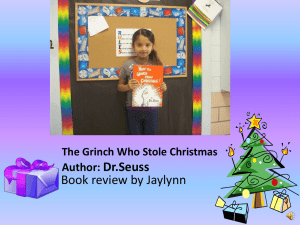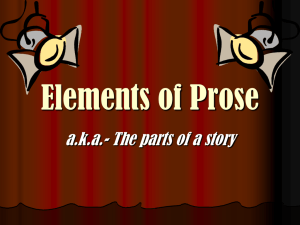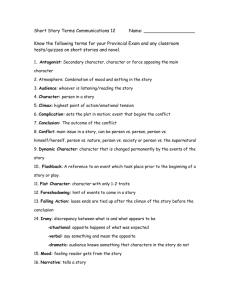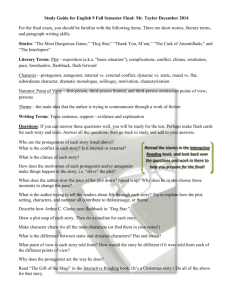Elements of Prose
advertisement
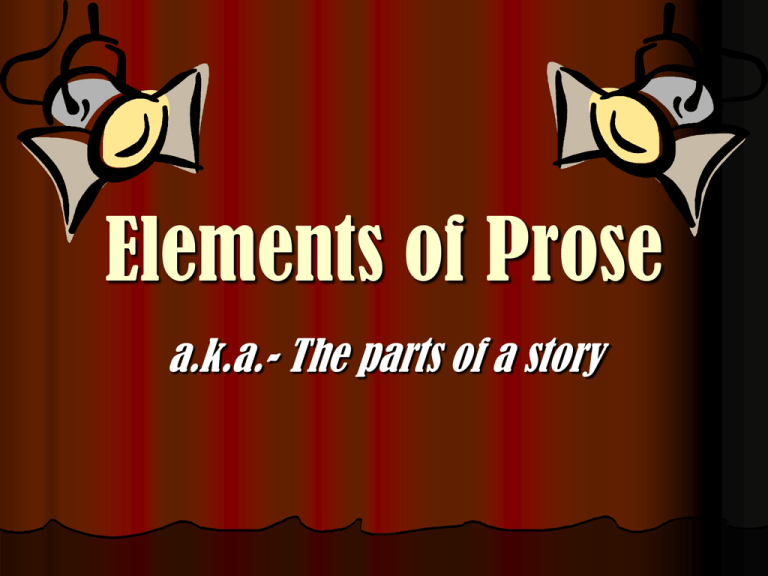
Elements of Prose a.k.a.- The parts of a story Prose There are 2 types of writing: prose- anything that is NOT poetry or plays poetry Prose is divided into 2 categories: short story novel Short Story Definition: Fictional story that can be read in one sitting. Example: “A Rose for Emily,” “The Cask of Amontillado,” or “The Most Dangerous Game” Novel Definition: A long prose narrative that must be read in many sittings. Example: To Kill a Mockingbird, The Scarlet Letter, or The Great Gatsby Elements of Prose Plot Character Setting Point of View Theme Irony Symbol Plot The “framework” or “skeleton” of the story; A series of related events that are linked together What Makes Up Plot? Basic Situation (Exposition) 1. - Tells the audience who the characters are and introduces the conflict - Example: “Every Who Down in Who-ville Liked Christmas a lot...” What Makes Up Plot? 2. Rising Action - Complications that arise when the characters take steps to resolve their conflicts “But the Grinch, Who lived just North of Who-ville, Did NOT! The Grinch hated Christmas! The whole Christmas season! Now, please don't ask why. No one quite knows the reason. What Makes Up Plot? 3. Climax: Most exciting or suspenseful moment when something happens to determine the outcome of the conflict. Example: “And the Grinch, with his grinch-feet ice-cold in the snow, Stood puzzling and puzzling: "How could it be so? It came without ribbons! It came without tags! "It came without packages, boxes or bags!" And he puzzled three hours, `till his puzzler was sore. Then the Grinch thought of something he hadn't before! "Maybe Christmas," he thought, "doesn't come from a store. "Maybe Christmas...perhaps...means a little bit more!" What Makes Up Plot? 4. Falling Action: The conflict is in the process of being resolved or “unraveled Example: And what happened then...? Well...in Who-ville they say That the Grinch's small hear Grew three sizes that day! What Makes Up Plot? Resolution: (Denouement) or “Untying the knot” When the story’s problem/conflict is resolved and the story ends Example: “He whizzed with his load through the Endings may be happy or tragic bright morning light And he brought back the toys! And the food for the feast! And he......HE HIMSELF...! The Grinch carved the roast beast!” Character: Revealing Human Nature Character- A person or being in a story that performs the action of the plot. Characterization: The process of revealing the personality of a character in a story. Types of Characters Dynamic Character: The character changes as a result of the action of the story. Example- Ebenezer Scrooge, the Grinch Static Character: The character does not change much in the course of the story. Example- Brutus (Julius Caesar); Mama Younger (A Raisin in the Sun) Types of Characters Protagonist: The main character of the story. Can be good or evil Antagonist: The character or force that comes into conflict with the protagonist Can be another person, an animal, a force of nature, society, the character’s own conscience, etc. Setting Defintion: The time and location in which the story takes place Theme Definition: The insight about human life that is revealed in a literary work. The “golden thread” woven throughout the story. -The theme is what the author is saying through the story (it’s a deeper truth about reality) - The plot how he says it : it is the story he uses to get this point across Point of View Definition: The direction from which the writer has chosen to tell the story There are 3 Points of View First Person: One of the characters tells the story; talks directly to the reader 1. - 2. Uses the pronoun “I,” “me,” “we,” or “us” Third Person Limited: The narrator will focus on the thoughts & feelings of just one character - Reader experiences the events of the story through the memory and senses of only one character There are 3 Points of View 3. Third-Person Omniscient- “All-knowing” - An all-knowing narrator who refers to all the characters as “he” and “she.” Knows the thoughts and feelings of ALL of the characters. *The narrator is not necessarily the story’s author* Irony Definition: An “unexpected twist” in a story
